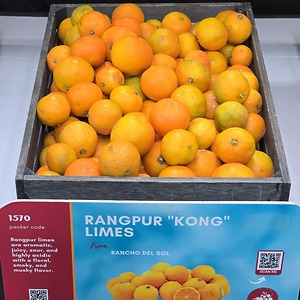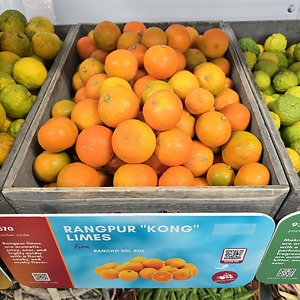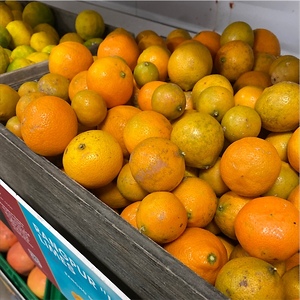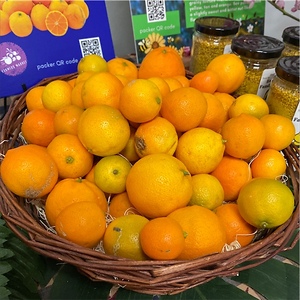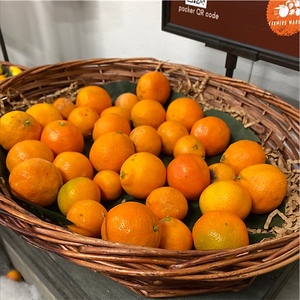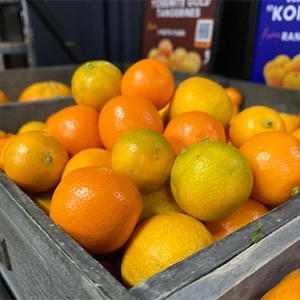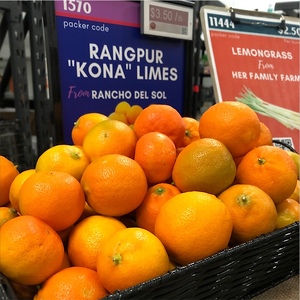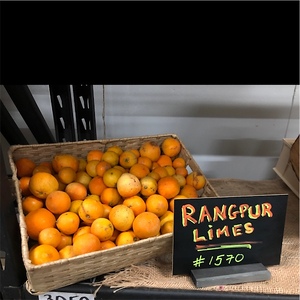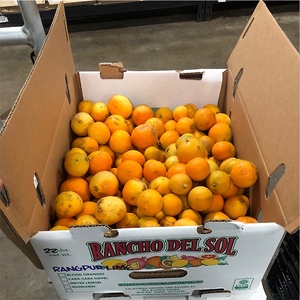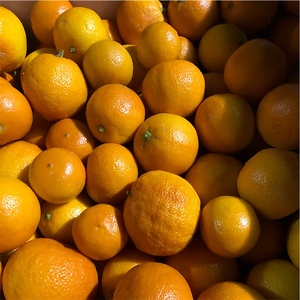

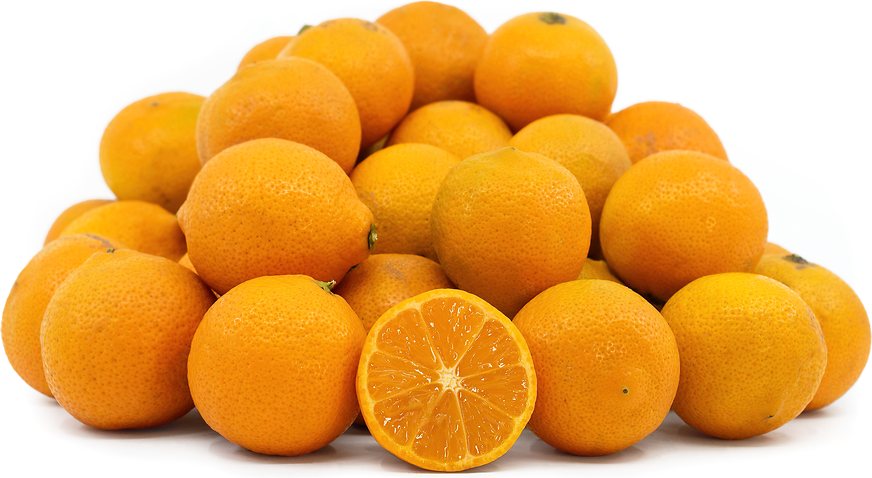
Rangpur "Kona" Limes
Estimated Inventory, lb : 0
This item was last sold on : 07/06/25
Description/Taste
Rangpur limes are small to medium in size, averaging 5 to 6 centimeters in diameter and 32 to 42 grams in weight, and have a round to oblate shape with a characteristic short and furrowed nipple. The variety’s thin rind ripens from green to red-orange and is moderately adhered to the flesh. The rind may remain green in some cultivation regions, even when ripe. The rind also showcases a semi-smooth surface covered in prominent oil glands or pores, giving the rind a pebbled, pocked appearance. As the rind is easily peeled away by hand, tender, soft, and aqueous flesh is revealed, divided into 8 to 10 segments by thin white membranes. The flesh also contains large, pulpy juice vesicles and is seeded, bearing anywhere from a few to many inedible, cream-colored seeds. Rangpur limes emit a floral, honeyed, and refreshing aroma and are edible raw in their slightly unripe and ripe stages. Rangpur lime juice will be more acidic, pungent, and bitter when somewhat unripe. Mature Rangpur limes initially have a sweet taste followed by a strong acidity, creating a sweet and sour taste with floral, smokey, and musky nuances.
Seasons/Availability
Rangpur limes are available in the fall through early spring.
Current Facts
Rangpur limes, botanically classified as Citrus limonia, are an Asian hybrid belonging to the Rutaceae or citrus family. The small, fragrant fruits grow on trees reaching up to six meters in height and have origins in Southern Asia, expanding over time to regions worldwide. Despite their lime moniker, Rangpur limes are not actual limes but a cross between a mandarin and a citron or lemon. The species developed their lime name for their subtly sweet, sour, and sometimes bitter taste, an acidic flavor reminiscent of limes. Worldwide, Rangpur limes have acquired several regional descriptors, including Sylhet, Surkh Nimboo, and Sharbati in India, Kona limes in Hawaii, Cravo lemon in Brazil, Hime lemon in Japan, Mandarin lime in the United States, Canton lemon in China, and Lemandarin, Marmalade lime, Rungpor, and Rungpur. It is estimated that there are over thirty-nine hybrids generally categorized under the Rangpur lime name, and the species is favored by growers for its disease resistance, cold tolerance, and overall hardiness. Mature Rangpur trees can produce 100 to 400 fruits per season, depending on the growing environment, and the fruits have been utilized for centuries as a flavoring agent in beverages and culinary preparations.
Nutritional Value
Rangpur limes are a source of fiber to regulate the digestive tract and potassium, phosphorus, and calcium to support bones and teeth while balancing fluid levels within the body. The variety also provides vitamin C to strengthen the immune system, iron to develop the protein hemoglobin for oxygen transport through the bloodstream, vitamin A to maintain healthy organs, and other nutrients, including folate, magnesium, copper, riboflavin, and thiamine. Citrus is known in natural medicines throughout Asia for its anti-inflammatory and antioxidant properties to reduce inflammation and guard the body's overall health.
Applications
Rangpur limes have a sweet, tart, bitter, and floral flavor suited for fresh and cooked preparations. The variety is primarily utilized as a flavoring agent and is not commonly eaten as a stand-alone fruit due to its acidic nature. Rangpur limes are pressed into juice and used to flavor smoothies, tropical fruit mixes, sparkling drinks, and other beverages. The juice is also incorporated into salad dressings, sauces, and marinades. In India, Rangpur limes are nicknamed “gandhraj,” meaning “king of fragrance.” The variety is zested over curries, dals, or vegetable dishes and is used as a marinade for roasted meat. Rangpur lime juice can also be added to creamy dips such as guacamole or hummus, squeezed over ceviche, or sprinkled over tacos and rice bowls. Beyond savory dishes, Rangpur limes can be used to flavor crème brulee, cheesecake, key lime pie, and other desserts. They can also be simmered into jams, marmalade, curds, and other preserves. Rangpur limes pair well with juniper berries, bay leaves, lavender, rosemary, honey, almonds, seafood, and meats such as pork, beef, and poultry. Whole, unwashed Rangpur limes will keep for a few days at room temperature and for 2 to 4 weeks in the fridge. The variety can also be kept in professional cold storage for up to five months.
Ethnic/Cultural Info
Rangpur limes gained notoriety in the early 21st century as a signature flavoring in the well-known Tanqueray gin brand. Tanqueray gin was established in the mid-19th century through the efforts of Charles and Edward Tanqueray. The brothers initially purchased space for their distillery in London and spent several years learning the skillset needed to make quality gin. Edward passed away only a few years into their venture, but Charles continued their dream and kept meticulous notes on flavors, blends, and thoughts from world travels in his recipe notebook. Charles eventually selected four main ingredients for his gin: juniper, coriander seeds, angelica root, and licorice, and he is known for being one of the first creators of London dry gin, a specific method of production using continuous distillation. Tanqueray gin expanded in brand recognition throughout Europe in the late 19th century and later in the 20th century, the company’s involvement throughout prohibition in the United States allowed the brand to become a household name. The musical Rat Pack also contributed to the brand’s fame in the 1960s when they were seen drinking Tanqueray martinis at the Buena Vista Social Club in San Fransisco. In the 21st century, Tanqueray gin began releasing exclusive types of gin infused with premium ingredients. Rangpur limes were used as the signature ingredient in a blend released in 2006 and were also combined with ginger and bay leaves. The citrus adds a refreshing and zesty aroma and flavor to the gin, and the premium gin is still made in the present day and is used as a base for cocktails.
Geography/History
Rangpur limes are native to the Indian subcontinent and have been growing wild since ancient times. Several theories exist about the species’ exact site of origin, as there are multiple regions of Northwestern India and Northern Bangladesh named Rangpur. Regardless of the origins, Rangpur limes are a natural hybrid of either a mandarin orange and a citron or a mandarin orange and a lemon. Over time, Rangpur limes were spread throughout the Indian subcontinent and were selected for cultivation. The species later traveled via trade routes to Southeast and East Asia and was planted in the United States in the late 19th century through nurseryman and avid botanists, the Reasoner brothers, in Oneco, Florida. It is said that the Reasoner brothers acquired seeds from India. The variety was also introduced to growers in Hawaii in the 1880s, thriving in the Big Island’s rich, volcanic soil. In the late 20th century, Rangpur limes were planted in the Givaudan Citrus Variety Collection in Riverside, California, and were initially received as budwood from Karnataka, India. They were also introduced to growers in South America, especially in Brazil, as hardy rootstock for commercial breeding. Today, Rangpur limes are cultivated in tropical to subtropical regions worldwide and are a specialty species planted as a home garden tree, small-scale commercial cultivar, and rootstock. When in season, the fruits are sold through local markets, directly through growers, or through select wholesalers, mainly in Asia, Europe, Australia, and the Americas.
Recipe Ideas
Recipes that include Rangpur "Kona" Limes. One



